最新语言学第二章
- 格式:doc
- 大小:55.00 KB
- 文档页数:21
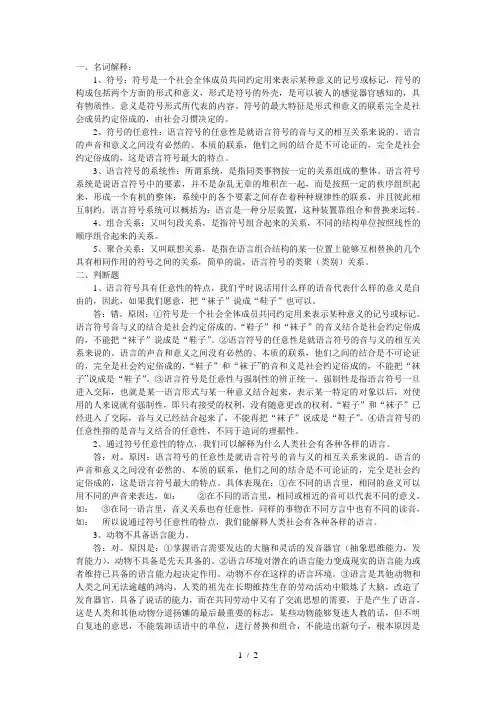
一、名词解释:1、符号:符号是一个社会全体成员共同约定用来表示某种意义的记号或标记,符号的构成包括两个方面的形式和意义,形式是符号的外壳,是可以被人的感觉器官感知的,具有物质性。
意义是符号形式所代表的内容。
符号的最大特征是形式和意义的联系完全是社会成员约定俗成的,由社会习惯决定的。
2、符号的任意性:语言符号的任意性是就语言符号的音与义的相互关系来说的。
语言的声音和意义之间没有必然的、本质的联系,他们之间的结合是不可论证的,完全是社会约定俗成的,这是语言符号最大的特点。
3、语言符号的系统性:所谓系统,是指同类事物按一定的关系组成的整体。
语言符号系统是说语言符号中的要素,并不是杂乱无章的堆积在一起,而是按照一定的秩序组织起来,形成一个有机的整体;系统中的各个要素之间存在着种种规律性的联系,并且彼此相互制约。
语言符号系统可以概括为:语言是一种分层装置,这种装置靠组合和替换来运转。
4、组合关系:又叫句段关系,是指符号组合起来的关系,不同的结构单位按照线性的顺序组合起来的关系。
5、聚合关系:又叫联想关系,是指在语言组合结构的某一位置上能够互相替换的几个具有相同作用的符号之间的关系,简单的说,语言符号的类聚(类别)关系。
二、判断题1、语言符号具有任意性的特点,我们平时说话用什么样的语音代表什么样的意义是自由的,因此,如果我们愿意,把“袜子”说成“鞋子”也可以。
答:错。
原因:①符号是一个社会全体成员共同约定用来表示某种意义的记号或标记。
语言符号音与义的结合是社会约定俗成的。
“鞋子”和“袜子”的音义结合是社会约定俗成的,不能把“袜子”说成是“鞋子”。
②语言符号的任意性是就语言符号的音与义的相互关系来说的。
语言的声音和意义之间没有必然的、本质的联系,他们之间的结合是不可论证的,完全是社会约定俗成的,“鞋子”和“袜子”的音和义是社会约定俗成的,不能把“袜子”说成是“鞋子”。
③语言符号是任意性与强制性的辨正统一,强制性是指语言符号一旦进入交际,也就是某一语言形式与某一种意义结合起来,表示某一特定的对象以后,对使用的人来说就有强制性,即只有接受的权利,没有随意更改的权利。

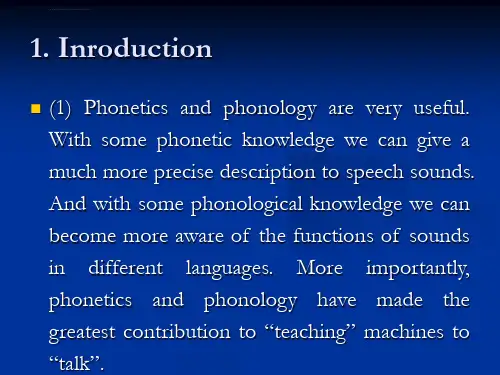

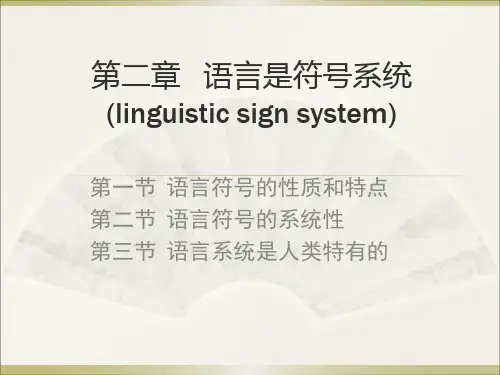

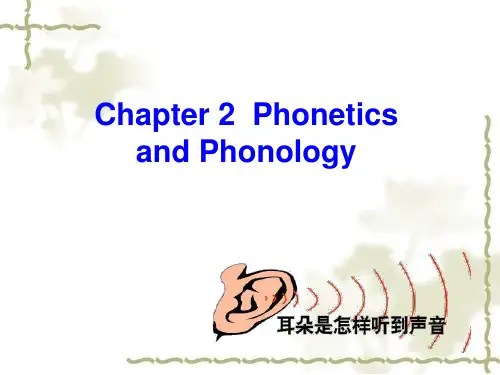
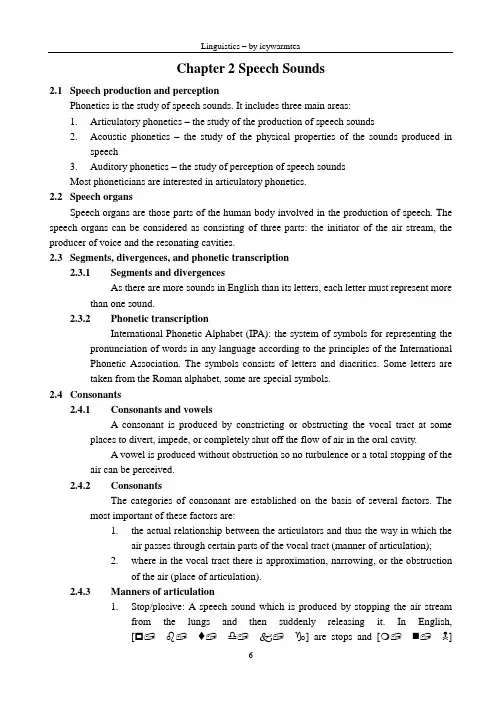
Chapter 2 Speech Sounds2.1 Speech production and perceptionPhonetics is the study of speech sounds. It includes three main areas:1. Articulatory phonetics – the study of the production of speech sounds2. Acoustic phonetics –the study of the physical properties of the sounds produced inspeech3. Auditory phonetics – the study of perception of speech soundsMost phoneticians are interested in articulatory phonetics.2.2 Speech organsSpeech organs are those parts of the human body involved in the production of speech. The speech organs can be considered as consisting of three parts: the initiator of the air stream, the producer of voice and the resonating cavities.2.3 Segments, divergences, and phonetic transcription2.3.1 Segments and divergencesAs there are more sounds in English than its letters, each letter must represent more than one sound.2.3.2 Phonetic transcriptionInternational Phonetic Alphabet (IPA): the system of symbols for representing the pronunciation of words in any language according to the principles of the InternationalPhonetic Association. The symbols consists of letters and diacritics. Some letters aretaken from the Roman alphabet, some are special symbols.2.4 Consonants2.4.1 Consonants and vowelsA consonant is produced by constricting or obstructing the vocal tract at someplaces to divert, impede, or completely shut off the flow of air in the oral cavity.A vowel is produced without obstruction so no turbulence or a total stopping of theair can be perceived.2.4.2 ConsonantsThe categories of consonant are established on the basis of several factors. The most important of these factors are:1. the actual relationship between the articulators and thus the way in which theair passes through certain parts of the vocal tract (manner of articulation);2. where in the vocal tract there is approximation, narrowing, or the obstructionof the air (place of articulation).2.4.3 Manners of articulation1. Stop/plosive: A speech sound which is produced by stopping the air streamfrom the lungs and then suddenly releasing it. In English,[☐ ♌ ♦ ♎ ♑] are stops and [❍ ⏹ ☠]are nasal stops.2. Fricative: A speech sound which is produced by allowing the air stream fromthe lungs to escape with friction. This is caused by bringing the twoarticulators, e.g. the upper teeth and the lower lip, close together but notcloses enough to stop the airstreams completely. In English,[♐ ❆ ♦ ☞ ✞ ♒] are fricatives.3. (Median) approximant: An articulation in which one articulator is close toanother, but without the vocal tract being narrowed to such an extent that aturbulent airstream is produced. In English this class of sounds includes[♦ ❑ ].4. Lateral (approximant): A speech sound which is produced by partiallyblocking the airstream from the lungs, usually by the tongue, but letting itescape at one or both sides of the blockage. [●] is the only lateral in English.Other consonantal articulations include trill, tap or flap, and affricate.2.4.4 Places of articulation1. Bilabial: A speech sound which is made with the two lips.2. Labiodental: A speech sound which is made with the lower lip and the upperfront teeth.3. Dental: A speech sound which is made by the tongue tip or blade and theupper front teeth.4. Alveolar: A speech sound which is made with the tongue tip or blade and thealveolar ridge.5. Postalveolar: A speech sound which is made with the tongue tip and the backof the alveolar ridge.6. Retroflex: A speech sound which is made with the tongue tip or blade curledback so that the underside of the tongue tip or blade forms a stricture with theback of the alveolar ridge or the hard palate.7. Palatal: A speech sound which is made with the front of the tongue and thehard palate.8. Velar: A speech sound which is made with the back of the tongue and the softpalate.9. Uvular: A speech sound which is made with the back of the tongue and theuvula, the short projection of the soft tissue and muscle at the posterior end ofthe velum.10. Pharyngeal: A speech sound which is made with the root of the tongue and thewalls of the pharynx.11. Glottal: A speech sound which is made with the two pieces of vocal foldspushed towards each other.2.4.5 The consonants of EnglishReceived Pronunciation (RP): The type of British Standard English pronunciation which has been regarded as the prestige variety and which shows no regional variation. It has often been popularly referred to as “BBC English” or “Oxford English” because it is widely used in the private sector of the education system and spoken by most newsreaders of the BBC network.articulation. These pairs of consonants are distinguished by voicing, the one appearingon the left is voiceless and the one on the right is voiced.Therefore, the consonants of English can be described in the following way:[p] voiceless bilabial stop[b] voiced bilabial stop[s] voiceless alveolar fricative[z] voiced alveolar fricative[m] bilabial nasal[n] alveolar nasal[l] alveolar lateral[j] palatal approximant[h] glottal fricative[r] alveolar approximant2.5 Vowels2.5.1 The criteria of vowel description1. The part of the tongue that is raised – front, center, or back.2. The extent to which the tongue rises in the direction of the palate. Normally,three or four degrees are recognized: high, mid (often divided into mid-highand mid-low) and low.3. The kind of opening made at the lips –various degrees of lip rounding orspreading.4. The position of the soft palate –raised for oral vowels, and lowered forvowels which have been nasalized.2.5.2 The theory of cardinal vowels[Icywarmtea doesn’t quite understand this theory.]Cardinal vowels are a set of vowel qualities arbitrarily defined, fixed and unchanging, intending to provide a frame of reference for the description of the actualvowels of existing languages.By convention, the eight primary cardinal vowels are numbered from one to eight as follows: CV1[♓], CV2[♏], CV3[☪], CV4[♋], CV5[ ], CV6[ ], CV7[☐],CV8[◆].A set of secondary cardinal vowels is obtained by reversing the lip-rounding for agive position: CV9 – CV16. [I am sorry I cannot type out many of these. If you want toknow, you may consult the textbook p. 47. – icywarmtea]2.5.3 Vowel glidesPure (monophthong) vowels: vowels which are produced without any noticeable change in vowel quality.V owel glides: V owels where there is an audible change of quality.Diphthong: A vowel which is usually considered as one distinctive vowel of a particular language but really involves two vowels, with one vowel gliding to the other.2.5.4 The vowels of RP[♓] high front tense unrounded vowel[◆] high back lax rounded vowel[☜] central lax unrounded vowel[ ] low back lax rounded vowel2.6 Coarticulation and phonetic transcription2.6.1 CoarticulationCoarticulation: The simultaneous or overlapping articulation of two successive phonological units.Anticipatory coarticulation: If the sound becomes more like the following sound, as in the case of lamp, it is known as anticipatory coarticulation.Perseverative coarticulation: If the sound displays the influence of the preceding sound, as in the case of map, it is perseverative coarticulation.Nasalization: Change or process by which vowels or consonants become nasal.Diacritics: Any mark in writing additional to a letter or other basic elements.2.6.2 Broad and narrow transcriptionsThe use of a simple set of symbols in our transcription is called a broad transcription. The use of more specific symbols to show more phonetic detail is referredto as a narrow transcription. The former was meant to indicate only these soundscapable of distinguishing one word from another in a given language while the latterwas meant to symbolize all the possible speech sounds, including even the minutestshades of pronunciation.2.7 Phonological analysisPhonetics is the study of speech sounds. It includes three main areas: articulatory phonetics, acoustic phonetics, and auditory phonetics. On the other hand, phonology studies the rules governing the structure, distribution, and sequencing of speech sounds and the shape of syllables.There is a fair degree of overlap in what concerns the two subjects, so sometimes it is hard to draw the boundary between them. Phonetics is the study of all possible speech sounds while phonology studies the way in which speakers of a language systematically use a selection of these sounds in order to express meaning. That is to say, phonology is concerned with the linguistic patterning of sounds in human languages, with its primary aim being to discover the principles that govern the way sounds are organized in languages, and to explain the variations that occur. 2.8 Phonemes and allophones2.8.1 Minimal pairsMinimal pairs are two words in a language which differ from each other by only one distinctive sound and which also differ in meaning. E.g. the English words tie anddie are minimal pairs as they differ in meaning and in their initial phonemes /t/ and /d/.By identifying the minimal pairs of a language, a phonologist can find out which soundsubstitutions cause differences of meaning.2.8.2 The phoneme theory2.8.3 AllophonesA phoneme is the smallest linguistic unit of sound that can signal a difference inmeaning. Any of the different forms of a phoneme is called its allophones. E.g. inEnglish, when the phoneme /☐/ occurs at the beginning of the word like peak/☐♓/, it is said with a little puff of air, it is aspirated. But when /☐/ occurs in theword like speak /♦☐♓/, it is said without the puff of the air, it is unaspirated. Boththe aspirated [☐♒] in peak and the unaspirated [☐=] in speak have the same phonemicfunction, i.e. they are both heard and identified as /☐/ and not as /♌/; they are bothallophones of the phoneme /☐/.2.9 Phonological processes2.9.1 AssimilationAssimilation: A process by which one sound takes on some or all the characteristics of a neighboring sound.Regressive assimilation: If a following sound is influencing a preceding sound, we call it regressive assimilation.Progressive assimilation: If a preceding sound is influencing a following sound, we call it progressive assimilation.Devoicing: A process by which voiced sounds become voiceless. Devoicing of voiced consonants often occurs in English when they are at the end of a word.2.9.2 Phonological processes and phonological rulesThe changes in assimilation, nasalization, dentalization, and velarization are all phonological processes in which a target or affected segment undergoes a structuralchange in certain environments or contexts. In each process the change is conditioned ortriggered by a following sound or, in the case of progressive assimilation, a precedingsound. Consequently, we can say that any phonological process must have three aspectsto it: a set of sounds to undergo the process; a set of sounds produced by the process; aset of situations in which the process applies.We can represent the process by mans of an arrow: voiced fricative →voiceless / __________ voiceless. This is a phonological rule. The slash (/) specifies theenvironment in which the change takes place. The bar (called the focus bar) indicatesthe position of the target segment. So the rule reads: a voiced fricative is transformedinto the corresponding voiceless sound when it appears before a voiceless sound.2.9.3 Rule ordering[No much to say, so omitted – icywarmtea]2.10 Distinctive featuresDistinctive feature: A particular characteristic which distinguishes one distinctive sound unit of a language from another or one group of sounds from another group.Binary feature: A property of a phoneme or a word which can be used to describe the phoneme or word. A binary feature is either present or absent. Binary features are also used to describe the semantic properties of words.2.11 SyllablesSuprasegmental features: Suprasegmental features are those aspects of speech that involve more than single sound segments. The principal suprasegmental features are syllables, stress, tone, and intonation.Syllable: A unit in speech which is often longer than one sound and smaller than a whole word.Open syllable: A syllable which ends in a vowel.Closed syllable: A syllable which ends in a consonant.Maximal onset principle: The principle which states that when there is a choice as to where to place a consonant, it is put into the onset rather than the coda. E.g. The correct syllabification of the word country should be / ✈⏹♦❑♓/. It shouldn’t be / ✈⏹♦❑♓/ or / ✈⏹♦❑♓/ according to this principle.2.12 StressStress refers to the degree of force used in producing a syllable. In transcription, a raised vertical line [ ] is used just before the syllable it relates to.。
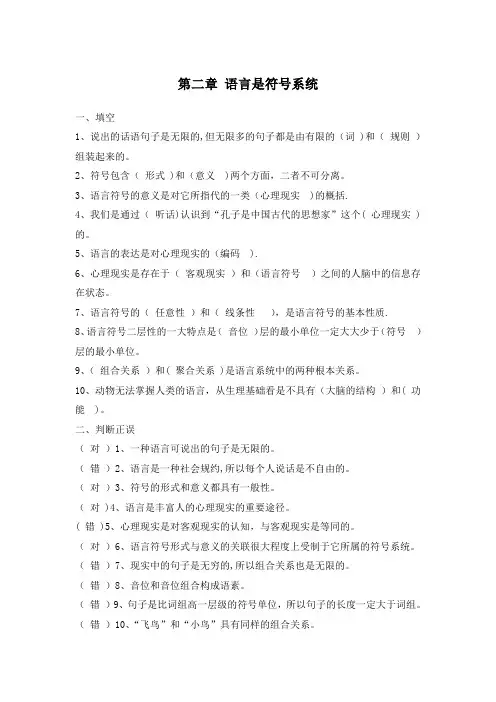
第二章语言是符号系统一、填空1、说出的话语句子是无限的,但无限多的句子都是由有限的(词 )和(规则)组装起来的。
2、符号包含(形式 )和(意义 )两个方面,二者不可分离。
3、语言符号的意义是对它所指代的一类(心理现实 )的概括.4、我们是通过(听话)认识到“孔子是中国古代的思想家”这个( 心理现实 )的。
5、语言的表达是对心理现实的(编码 ).6、心理现实是存在于(客观现实)和(语言符号)之间的人脑中的信息存在状态。
7、语言符号的(任意性)和(线条性),是语言符号的基本性质.8、语言符号二层性的一大特点是(音位)层的最小单位一定大大少于(符号)层的最小单位。
9、(组合关系)和( 聚合关系 )是语言系统中的两种根本关系。
10、动物无法掌握人类的语言,从生理基础看是不具有(大脑的结构)和( 功能 )。
二、判断正误(对)1、一种语言可说出的句子是无限的。
(错)2、语言是一种社会规约,所以每个人说话是不自由的。
(对)3、符号的形式和意义都具有一般性。
(对 )4、语言是丰富人的心理现实的重要途径。
( 错 )5、心理现实是对客观现实的认知,与客观现实是等同的。
(对)6、语言符号形式与意义的关联很大程度上受制于它所属的符号系统。
(错)7、现实中的句子是无穷的,所以组合关系也是无限的。
(错)8、音位和音位组合构成语素。
(错)9、句子是比词组高一层级的符号单位,所以句子的长度一定大于词组。
(错)10、“飞鸟”和“小鸟”具有同样的组合关系。
三、思考题1、听到一个熟人在说话,就能判断出是谁在说话,这个过程是语言符号在传递信息吗?为什么?这是语言符号在传递信息。
因为符号存在形式和意义两个方面,语言符号传递信息都是通过将意义与形式组合的。
但是语言符号的形式与一般符号的形式不同,它是一种声音实体.每个人说话都有自己独特之处,如音高、响亮度等发音的特点,我们听一个人说话,长时间地接触后,就将这种声音特点与意义结合了起来,从而理解了这种声音所传送的意义。
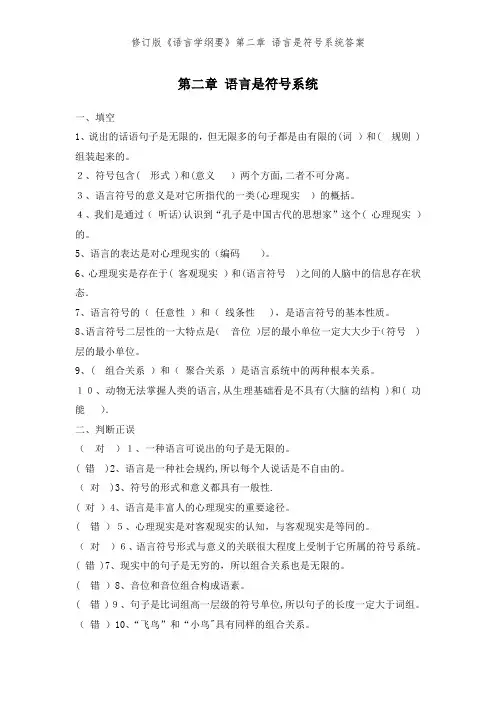
第二章语言是符号系统一、填空1、说出的话语句子是无限的,但无限多的句子都是由有限的(词)和( 规则 )组装起来的。
2、符号包含( 形式 )和(意义)两个方面,二者不可分离。
3、语言符号的意义是对它所指代的一类(心理现实)的概括。
4、我们是通过(听话)认识到“孔子是中国古代的思想家”这个( 心理现实)的。
5、语言的表达是对心理现实的(编码)。
6、心理现实是存在于( 客观现实)和(语言符号 )之间的人脑中的信息存在状态.7、语言符号的(任意性)和(线条性 ),是语言符号的基本性质。
8、语言符号二层性的一大特点是(音位)层的最小单位一定大大少于(符号 )层的最小单位。
9、( 组合关系)和(聚合关系)是语言系统中的两种根本关系。
10、动物无法掌握人类的语言,从生理基础看是不具有(大脑的结构 )和( 功能).二、判断正误(对)1、一种语言可说出的句子是无限的。
( 错)2、语言是一种社会规约,所以每个人说话是不自由的。
(对)3、符号的形式和意义都具有一般性.( 对)4、语言是丰富人的心理现实的重要途径。
( 错)5、心理现实是对客观现实的认知,与客观现实是等同的。
(对)6、语言符号形式与意义的关联很大程度上受制于它所属的符号系统。
( 错 )7、现实中的句子是无穷的,所以组合关系也是无限的。
( 错)8、音位和音位组合构成语素。
( 错 )9、句子是比词组高一层级的符号单位,所以句子的长度一定大于词组。
(错)10、“飞鸟”和“小鸟"具有同样的组合关系。
三、思考题1、听到一个熟人在说话,就能判断出是谁在说话,这个过程是语言符号在传递信息吗?为什么?这是语言符号在传递信息。
因为符号存在形式和意义两个方面,语言符号传递信息都是通过将意义与形式组合的。
但是语言符号的形式与一般符号的形式不同,它是一种声音实体。
每个人说话都有自己独特之处,如音高、响亮度等发音的特点,我们听一个人说话,长时间地接触后,就将这种声音特点与意义结合了起来,从而理解了这种声音所传送的意义.2、语言符号如何增进人的认识客观现实的能力?心理现实为语言符号的最初编码提供了初步的材料。

英语语言学第二章讲课课件一、教学内容本节课我们将学习英语语言学第二章,主要内容包括:语系与语言分类、语音学与音系学基础、以及词汇学初步。
具体涉及教材第二章的13节,重点探讨语言的起源、语言如何通过语音和词汇表达意义,以及不同语言之间的相似与差异。
二、教学目标1. 理解世界主要语系的特点及其分类依据,能列举至少三种语系并说明其代表性语言。
2. 掌握语音学基本概念,识别不同语音特征,并能在实际语境中进行应用。
3. 运用词汇学知识分析词语构成,提高词汇理解和运用能力。
三、教学难点与重点重点:语音学基本概念、词汇学的主要理论。
难点:语音的发音规则、词汇在不同语境中的应用。
四、教具与学具准备教具:PPT展示、录音机、语音示例CD。
学具:笔记本、词典、语音学基础教材。
五、教学过程1. 导入(5分钟):通过展示世界地图,引入不同地区语言的多样性,激发学生对语言起源和分类的兴趣。
2. 理论讲解(20分钟):介绍语系分类、语音学基础和词汇学构成,结合教材第二章13节内容。
3. 实践情景引入(10分钟):播放不同语言的问候语录音,让学生体验语言差异。
4. 例题讲解(15分钟):讲解语音学中元音、辅音的分类及发音规则,通过例词进行示范。
5. 随堂练习(10分钟):分组进行语音模仿和词汇构造练习。
六、板书设计1. 语系与语言分类印欧语系汉藏语系阿尔泰语系2. 语音学基础元音与辅音发音规则3. 词汇学初步词根、词缀词语构成七、作业设计beautifulunderstand2. 答案:beautiful: beauty, beautifully, beastunderstand: understanding, understandable, misunderstand八、课后反思及拓展延伸1. 反思:关注学生在课堂上的参与度,针对语音模仿环节进行教学调整,提高学生的发音准确性。
2. 拓展延伸:鼓励学生课下阅读更多关于语音学和词汇学的资料,了解语言的发展趋势及其背后的文化因素。
1第二章音系学21.语言的声音媒介3语言的形式有声音和文字。
在这两种媒介中,声音是语言最基本的媒介,4是第一性的。
这是因为在语言的发展过程中,声音媒介早于文字。
文字是对声5音的记录。
在日常交际中,大量信息是通过口头交际来完成的,只有在无法进6行口头交际的情况下人们才使用文字形式。
除此之外,人们是通过声音媒介来7习得自己的母语的。
82. 语音学2.1什么是语音学910语音学研究的对象是语言的声音媒介,即人类语言中使用的全部语音。
11语音学有三个分支:发声语音学、听觉语音学和声学语音学。
它们各有自12己的侧重点但又互有联系。
发声语音学主要研究语言使用者是如何使用发音器13官发出语音,并对所发出的音进行分类。
听觉语音学主要是从受话人的角度来14研究语音,即语音是如何被受话人感知和理解的。
声学语音学主要研究语音的15物理特性。
通过对语音声波的研究,声学语音学家得出了一些重要的结论。
最16为重要的结论,所说出的这些通常被认为是同一个话语,如果从声音的物理特17性上去分析,其实它们的声波并不相同,只是由于它们之间存在的差异太小,18是人耳所不能辨别的。
如果它们的声波相同,这只是一种巧合。
因此,语音的19等同只是一种理论上的理想。
202.2发音器官2122人类的发音器官存在于咽腔、口腔和鼻腔腔内。
咽腔内最重要的发音器官是位于喉头的声带,发音时声带在气流的冲击下发生颤动决定了声音的浊2324音化(voicing)。
浊音化是所有元音以及部分辅音,如[b],[g],[m]等所具有的25特性。
声带不发生颤动所发出的音是清音,如[t],[k],[f]等。
声带颤动的频率决定了声音的高低。
口腔中发音器官最多,有舌头、小舌、软腭、硬腭、齿龈2627隆骨、牙齿和嘴唇。
其中舌头是最灵活、最重要的发音器官。
发音时,来自肺28部的气流在口腔中受到不同的阻碍,从而发出不同的音。
29鼻腔和口腔相通。
发音时软腭后移关闭鼻腔,气流只能从口腔通过,30所发出的音没有鼻音化。
但当鼻腔通道打开,允许气流从鼻腔通过,所发出来31的音便是鼻音。
2.3音标——宽式和严式标音法3233音标是在国际上被广为接受的一套对语音进行标音的标准符号体系。
34标音分为宽式和严式标音法。
宽式标音法是用一个符号来表示一个语音的标音方式。
严式标音法是一种使用变音符号的标音方式,旨在记录同一个音在不同3536的语音环境下所发生的细微的变化,如在star和tar中的/t/的发音就不一样,37前者/t/是不送气音,后者/t/是送气音。
这些细微区别只有通过严式标音法才38能表示。
392.4英语语音的分类40英语中的语音根据气流的受阻情况分为元音和辅音。
气流没有受到任何阻碍所发出的音是元音;气流在口腔里受到不同方式的阻碍所发出的音是辅4142音。
432.4.1英语辅音的分类根据发音方式,英语的辅音可以分为:44451)爆破音:发爆破音时,气流开始完全受阻,然后突然释放,如[p],[b],[t],[d],[k],[g]46472)摩擦音:发摩擦音时,气流部分受阻,气流从狭窄的通道挤出,产生摩48擦,如[f],[v],[s],[z],[ θ],[ T ], [∫ ], [ V ], [h]3)塞擦音:发塞擦音时,气流开始完全受阻,然后气流从狭窄通道缓慢释4950放,并伴有摩擦发生,如:[t∫], [dV ]514)流音:在发流音时,受阻的气流从舌头与上部(roof of the mouth)52形成的通道释放出,如:[l],[r]。
535)鼻音:发音时,气流从鼻腔释放出所发出的音为鼻音,如[n],[m],[N ] 546)滑音:滑音又称之为半元音。
英语中滑音有[w]和[j]。
它们的发音方55式与[u]和[i]相同。
56根据发音部位,英语辅音可以分为:571)双唇音:气流受阻部位在双唇,如[p],[b],[m],[w]582)唇齿音:下唇与上齿接触使气流受阻,如[f],[v]593)齿音:舌尖与上齿接触使气流受阻,如:[θ],[ T]604)齿龈音:舌尖与上齿龈隆骨接触使气流受阻,如:61[t],[d],[s],[z],[n],[l],[r]625)腭音:受阻部位发生在舌根与硬腭之间,如:[∫], [ V],[ t∫ ], [dV ], 63[j]6)软腭音:舌根与软腭接触使气流受阻,如: [k], [g], [ N ]64657)喉音:声带短时接触使气流受阻,如:[h]66元音与辅音不同,不能根据辅音的发音方式和发音部位来分类。
元音常67根据舌位的高低、开口度、嘴唇形状、元音的长度和发音时喉部的紧张程度来68分类。
691)舌位的高低70发音时,舌头前部抬得最高的音为前元音,通常有:[i:] [i] [e] [A] [a].71发音时,舌头的中部抬得最高为中元音,如:[\:], [[],[Q]72发音时,舌根部位抬得最高为后元音,如:[u:] [J] [ C:], [ ]and [B:].732)开口度:根据开口度,通常把元音分为以下四种:7475闭元音:如:[i:],[ i],[u:],[J]76半闭元音:如:[e], [з: ]半开元音:如[ [ ], [ C: ]7778开元音:如:[?], [a], [Λ], [ ], [ɑ:]793)嘴唇形状:圆唇元音:英语中除了[ɑ:]以外,所有的后元音都是圆唇元音。
8081不圆唇元音:英语中所有的前元音和中元音都是不圆唇元音。
824)元音的长度:根据发音的长度,元音分为长元音和短元音。
长元音常83用一个分号来表示。
英语中长元音有:[i:] [\:] [ C: ] [u:] [ɑ:],其余都84是短元音。
855)根据发音时喉部的紧张程度把元音分为紧元音和松元音。
6)除了单元音外,英语中还有一组双元音,如:[ ei ] [ai] [Eu] [aJ ]8687[Ci ] [iE] [eE] [JE]。
88根据以上标准,我们可以对元音进行描述,如[e]被描述为前、半闭合、不圆唇元音。
89903.音系学913.1音系学和语音学92音系学和语音学都是对语音的研究,它们有联系但又有区别。
93语音学研究对象是人类所有语言的语音,它主要是对语音进行描述和分94类,如,音的发音方式,音的语音特征,以及音与音之间的差别;音系学研究的是某一特定语言的语音体系,即音在特定的语言中是如何结合产生有意义的9596单位来进行交际。
音系学家不关注不具备语义区别性价值的语音,而语音学家97既研究具有语义区别性价值的音,也研究不具备语义区别性价值的音。
3.2音素、音位、音位变体9899音素是语音学研究的单位。
人类在说语言时所发出的一切音都是音素100(phone),有些音素具有语义区别性价值,有些音素没有。
如:在单词feel[fi:?], 101leaf[li:f], tar[tha:], star[sta:]中,一共有7个音素,分别是[f],[i:],[?], 102[l], [th]. [t], [a:]。
103音系学研究的基本单位是音位,音位具有区别性价值,音位是抽象的,是一组语音特征的集合,它不是一个具体的音。
一个音位会在不同的语音环境104105中实现为具体的音,如音位/p/在语境中可实现为具体的送气和不送气音等,这106种语音的细微差别可在单词spade和pay中的/p/的发音可以看出。
音位在特定的语音环境里的具体体现形成音位变体,同一个音位在不同的语音环境里体现107108为不同的变体称之为音位变体如,音位/t/在star和tar中分别实现为不送气[t]和送气[th],因此不送气[t]和送气[th]为音位/t/的音位变体。
1091103.3音位对立、互补分布.最小对立对111如果两个音位可以出现在相同的语音环境中,且具有区别语义的功能,那么它们就形成了音位对立。
如tip和dip中的/t/和/d/占据了相同的语音112113位置,且具有区分语义的价值,因此/t/和/d/形成音位对立。
互补分布体现的114是同一音位不同音位变体之间的关系。
如果在语音上相似的两个音不能出现在115相同的位置上,且没有区别意义的功能,那么它们之间的关系就是互补分布关116系。
如top中送气的[th]和stop中不送气的[t]的关系是互补关系,如果把stop117中的[t]发成了送气音并不影响语义。
最小对立对指的是两个语音群(通常是单词)中的语音除了一个音不同,118119且不同的音处在相同的位置上,其余的成分完全相同,因此这两个语音群形成120最小对立对。
如tip和dip形成最小对立对,其中/-ip/完全相同,只有第一个音不同。
构成最小对立对的还有/pig/和/dig/;/pen/和/ben/;/robe/和/rote/ 121122等,但是/tip/和/pit/,/mop//opt/不构成最小对立对。
1233.4几条音系规则124125音系规则因语言的不同而不同,适用于一种语言的音系规则未必适用于另126一种语言。
1273.4.1序列规则:序列规则是关于音与音之间的结合规则。
例如,在英语128中,如果一个单词是以[l]或[r]为首音的话,那么后边紧跟的音必须是元音。
129英语中的三辅音连缀需遵守以下序列规则:1.第一个音位必须是: /s/1301312. 第二个音位必须是: /p/ 或 /t/或 /k/3. 第三个音位必须是: /l/ 或 /r/ 或 /w/1321333.4.2同化规则:134由于两个邻近的音相互影响使得两个音的发音出现类似现象,称之为同化。
135同化现象遵循一定规则即同化规则。
英语中,鼻音化并不具有语义区别性特征,136但是这并等于说,英语中元音没有鼻音化现象。
以元音[i:]为例,当它后面紧137跟[n]或[m]时,会出现[i:]的鼻音化现象,这也成了英语同化规则之一。
再以齿龈音[n]为例,它的发音常受到后面辅音的影响。
当它后面紧接齿龈音时,[n] 138139的发音是齿龈鼻音,如indirect [indi’rekt],但是当[n]后面紧接软腭音[k]140时,[n]会发生同化现象变为齿龈鼻音[?],如incorrect[i?kE’rekt]。
声音的同化在拼写中可以得到体现。
如[n]后接双唇音时会同化为[m],这一同化现象使141142得possible的否定形式变成impossible, 而不是inpossible。
/in-/在以下单143词中的不同的拼写如/ir-/和/il-/等都是[n]与后边音同化的结果,如illegal,144irregular等。
当然也有一些音虽然发生了同化,但是并没有在拼写中体现出来。
145如input中的[n]虽然受到[p]的同化发生音变,但是这种音变并没有体现在拼146写之中。